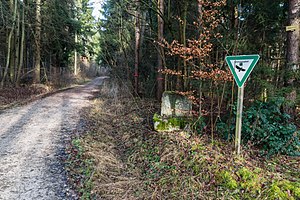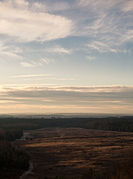Tennenloher Forest
|
Tennenloher Forest
|
||
|
Access to the nature reserve |
||
| location | Forst Tennenlohe , Erlangen-Höchstadt district , Bavaria | |
| surface | 955.95 | |
| Identifier | NSG-00483.01 | |
| WDPA ID | 165851 | |
| Geographical location | 49 ° 34 ' N , 11 ° 3' E | |
|
|
||
| Setup date | 1994 | |
| administration | Erlangen-Höchstadt | |
The Tennenloher Forest is an east of Erlanger district Tennenlohe located nature reserve .
location
It extends over an area of 934 hectares within the Sebalder Reichswald , the part of the Nuremberg Reichswald north of the Pegnitz . The nature reserve lies in the area of the community-free areas of Forst Tennenlohe , Buckenhofer Forst , Dormitzer Forst and Neunhofer Forst in the Erlangen-Höchstadt district .
history
In 1935 the Reichswehr cleared 195 hectares of forest. After the Second World War , the US Army used the site as a military training area until it withdrew in 1993 . In order to prevent high-flying projectiles from hitting the wood in the forest area behind and to prevent forest fires that can be caused by tracer ammunition , a particularly high ballistic barrier was built in the middle of the area . This became a popular destination after the Americans left. Because dud ammunition is in the ground there, there is a route requirement .
In 1994 the Tennenloher Forest was designated as a nature reserve. Rare animals and plants had settled on the dry sand areas of the earlier Range 6 shooting range. After the end of military use, human interventions were and are repeatedly required in order to maintain the large open spaces on sandy soils that would otherwise become forested in a short time.
After the designation as a nature reserve, the open areas are now grazed with horses and goats. The grazing project of the Middle Franconian Landscape Management Association with Przewalski horses from the Nuremberg Zoo and the Hellabrunn Zoo has been keeping the poor grass open since 2003.
To curb the growth of trees, especially the invasive North American late blooming bird cherry (Prunus serotina), a peacock goat herd was used in 2012 as part of a project by the district of Erlangen-Höchstadt (as a local authority) and two private goat farmers. The herd has grown to 65 animals to date.
In 2011, the grazing area was expanded to a total of over 90 hectares by fencing in the open area to the west (former shooting range) and in 2016 in the southern part. The paths along the gate are safe to walk on (military contaminated sites); a step over enables the crossing at a narrow point.
natural reserve
The 934 hectare “Tennenloher Forst” nature reserve is one of the largest sand ecosystems in southern Germany and is home to over 1,600 animal and plant species, many of which are on the red list . The core area of the nature reserve is around 100 hectares of open space from the former Range 6 shooting range. After American tanks had kept the area open until 1994, desertification with riding grass and bushes with pine, birch and bird cherry began in the following years. The goal of nature conservation, however, is to preserve the open sand habitats. Rare and endangered species such as the blue-winged sand insect or the blue-winged wasteland insect , digger wasps or silver grass are adapted to these locations and disappear with increasing encroachment. Grazing with goats and horses prevents this.
In addition to the centrally located open areas of the former shooting range, there are also the open areas on Geyersberg (another former shooting range in the nature reserve), which are particularly important as a breeding ground for woodlarks. This area, with a size of approx. 5 hectares, is also grazed with goats to keep it open.
In addition, there are valuable bog areas and pools with peat moss (Sphagnum), water hose (Utricularia) and sundew (Drosera) in the extensive forest areas.
There are information boards along the fence and at special biotopes.
The area is part of the Fauna-Flora-Habitat- Area Sandheiden in the Central Franconian Basin (FFH-No. 6432-3012; WDPA-No. 555521542) and the bird sanctuary Nuremberg Reichswald (FFH-No. 6533-471; WDPA-No. 555537802 ).
Picture gallery
Web links
- Sand axis Franconia
- Information about the nature reserve and the wild horses (nature / environment)
- Regulation nature reserve
Individual evidence
- ↑ OpenStreetMap: Location and extent of the nature reserve (accessed on January 9, 2016)
- ↑ Practice metal detection: "Splitterwood"
- ↑ Goats in the Erlangen-Höchstadt district (accessed on May 30, 2013)










